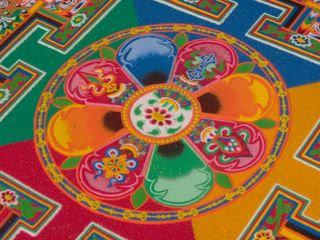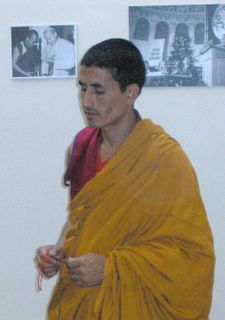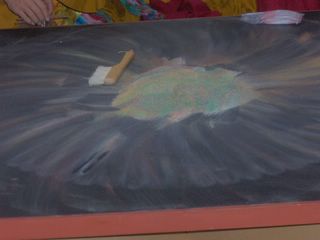Friday, July 15, 2005
Something beautiful (continued)

Click on photo to enlarge
I was entranced when some months ago Lorianne wrote about and photographed Tibetan Buddhist nuns constructing a sand mandala, so when I heard that as part of the celebrations of the Dalai Lama’s 70th birthday, monks visiting from Tashi Lhumpo Monastery in Karnataka would be making a mandala in London, I was determined to go and see them. It turned out to be a funny old week, though, and the first time I could make it was for the closing view and ceremonial dismantling of the mandala last Thursday.

The day after the bombs exploded in Central London, the monks began, in the basement of a Clerkenwell art gallery, their week of painstaking work constructing this symbol of peace and compassion, while the city around them reverberated with pain and shock.
It is cool at first in the basement on this afternoon of baking hot sunshine, but as the place fills up with a large crowd it becomes very, very hot. The mandala is complete - and gorgeous. The monks pace to and fro methodically, tidying away their tools, laying out their ceremonial costumes and arranging ritual offerings. Dimunitive Tibetan women worriedly urge us to stand well back.
When everything is ready, the crowd sits down and a sweet, giggly monk speaks about compassion. He is so peaceful, the wooden floor so shiny, the room so warm, I struggle not to fall asleep.

click on photo to enlarge
This is the Chenrezig Sand Mandala. Chenrezig (Avalokiteshvara), Bodhisattva of Compassion, is symbolised by a lotus on a throne at the centre. To the East, the entrance point, is a blue dorje (noble stone) symbolising Buddha Akshobhya; on the red petal to the South is a yellow jewel symbolising Buddha Ratnasambhava. In the North is a green sword representing the symbol of Buddha Amoghasiddi, and in the West a white dharma wheel. Each is placed upon a lotus and moon throne. They are surrounded by a protective mala (rosary) emanating from the heart of Chenrezig. Surrounding the central residence of the Buddhas are five walls made of coloured glass, representing the Five Wisdoms. The floor of the mansion is divided into four triangles, which extend beneath the central lotus: East is blue, South yellow, North green and West red. These are also the colours of the gates, each topped by a wheel of dharma, with two deer seated on each side Outside the five coloured inner walls of the palace are designs of lotus flowers on a red background, representing the Sixteen Offering Goddesses. The mandala is placed inside a thousand-petalled lotus flower, outside which is another protective mala, and finally a protective ring of fire. Traditionally, the practitioner would visualise circumambulating the palace, starting at the Eastern gate, whilst meditating on compassion - on the Tantra of Avalokiteshvara, visualising purity. The mandala is constructed to bring peace and harmony.

The six monks take up their places behind the mandala, don their ceremonial hats and begin deep chanting and blowing of horns. It is haunting, deep in every sense. It is also hot and airless. I remember fainting in church as a kid during interminable high-Anglican services of incense and chanting. Tired and tense, rigid with anxiety since the bombs, I feel very English, very me, unable to surrender to the flowing colours and sounds of this ritual. Breathe. Join with it. At moments I can.


Then it is over, a pinch of sand is taken from the representation of each Boddhisatva, symbolising their departure, a dorje dragged from each corner across the mandala, and all the sand gently brushed away – the week of painstaking work surrendered, the compassion shared, only a swirl of pastel shadows left, then a bare table-top. Everyone presses forward to take their little bag of sand, the beauty still imprinted on our eyelids, the compassion still in the room.
It's a happy thought that this was taking shape in London throughout this past week.

Click on photo to enlarge
I was entranced when some months ago Lorianne wrote about and photographed Tibetan Buddhist nuns constructing a sand mandala, so when I heard that as part of the celebrations of the Dalai Lama’s 70th birthday, monks visiting from Tashi Lhumpo Monastery in Karnataka would be making a mandala in London, I was determined to go and see them. It turned out to be a funny old week, though, and the first time I could make it was for the closing view and ceremonial dismantling of the mandala last Thursday.

The day after the bombs exploded in Central London, the monks began, in the basement of a Clerkenwell art gallery, their week of painstaking work constructing this symbol of peace and compassion, while the city around them reverberated with pain and shock.
It is cool at first in the basement on this afternoon of baking hot sunshine, but as the place fills up with a large crowd it becomes very, very hot. The mandala is complete - and gorgeous. The monks pace to and fro methodically, tidying away their tools, laying out their ceremonial costumes and arranging ritual offerings. Dimunitive Tibetan women worriedly urge us to stand well back.
When everything is ready, the crowd sits down and a sweet, giggly monk speaks about compassion. He is so peaceful, the wooden floor so shiny, the room so warm, I struggle not to fall asleep.

click on photo to enlarge
This is the Chenrezig Sand Mandala. Chenrezig (Avalokiteshvara), Bodhisattva of Compassion, is symbolised by a lotus on a throne at the centre. To the East, the entrance point, is a blue dorje (noble stone) symbolising Buddha Akshobhya; on the red petal to the South is a yellow jewel symbolising Buddha Ratnasambhava. In the North is a green sword representing the symbol of Buddha Amoghasiddi, and in the West a white dharma wheel. Each is placed upon a lotus and moon throne. They are surrounded by a protective mala (rosary) emanating from the heart of Chenrezig. Surrounding the central residence of the Buddhas are five walls made of coloured glass, representing the Five Wisdoms. The floor of the mansion is divided into four triangles, which extend beneath the central lotus: East is blue, South yellow, North green and West red. These are also the colours of the gates, each topped by a wheel of dharma, with two deer seated on each side Outside the five coloured inner walls of the palace are designs of lotus flowers on a red background, representing the Sixteen Offering Goddesses. The mandala is placed inside a thousand-petalled lotus flower, outside which is another protective mala, and finally a protective ring of fire. Traditionally, the practitioner would visualise circumambulating the palace, starting at the Eastern gate, whilst meditating on compassion - on the Tantra of Avalokiteshvara, visualising purity. The mandala is constructed to bring peace and harmony.

The six monks take up their places behind the mandala, don their ceremonial hats and begin deep chanting and blowing of horns. It is haunting, deep in every sense. It is also hot and airless. I remember fainting in church as a kid during interminable high-Anglican services of incense and chanting. Tired and tense, rigid with anxiety since the bombs, I feel very English, very me, unable to surrender to the flowing colours and sounds of this ritual. Breathe. Join with it. At moments I can.


Then it is over, a pinch of sand is taken from the representation of each Boddhisatva, symbolising their departure, a dorje dragged from each corner across the mandala, and all the sand gently brushed away – the week of painstaking work surrendered, the compassion shared, only a swirl of pastel shadows left, then a bare table-top. Everyone presses forward to take their little bag of sand, the beauty still imprinted on our eyelids, the compassion still in the room.
It's a happy thought that this was taking shape in London throughout this past week.
Comments:
<< Home
I knew one person, of a dozen, taken hostage by a violent nut-job at the Salt Lake City Library during a Tibetan Buddhist sand painting ceremony. An off duty cop managed to get himself taken as well, and would eventually rescue all the hostages. The monks, during the crisis, prayed outside. I like to think their prayers helped. I believe so.
Life is not about ease and peace, but striving for them despite the noise and violence around us.
Life is not about ease and peace, but striving for them despite the noise and violence around us.
Jean, I know it's a Tibetan Buddhist sand painting, and I've copied it over to my Xanga site to share it, with credit to you and a link back here, to your blog. Let me know if that's a problem, and I'll take it down immediately. I'm too impatient to await your answer, but if it happens again, I promise I will! It's exquisite.
How beautiful. Maybe the timing of this event was not coincidental. Thank you so much for telling us about it.
To write this as it was happening against the backdrop of the London bombs, stunning, thought-provoking, healing, amazing... Thank you so much for sharing. xo
Wow...how gorgeous. And how wonderful that you saw the dismantling as well: a snowstorm prevented me from seeing that part of the process here.
There's some sort of metaphor about beauty & impermanence in the timing of this event. Thanks for inviting us to draw that metaphor.
There's some sort of metaphor about beauty & impermanence in the timing of this event. Thanks for inviting us to draw that metaphor.
beautiful jean, how good to read something positive in the world whilst all that distruction was going on.
This brought tears to my eyes, actually. Because it's so much the way I picture the contest between good and evil. Evil has the noise and the splashy events and it fills the papers and, if we're not careful, our minds, but goodness is accumulating quietly, grain by grain, in unnoticed barely footnoted places, making beautiful things and letting them go.
There's far more of it than there is of evil, really. If there weren't it would all have all been crushed by the pressure of horrible events, long ago.
There's far more of it than there is of evil, really. If there weren't it would all have all been crushed by the pressure of horrible events, long ago.
Very nice pics and description Jean! Did you get sand? Did they take the rest of the sand to the river?
We witnessed a similar ceremony here a few years back. Not having a river nearby, they took it to a nearby manmade lake and had a ceremony there. I think half the enjoyment for me was in seeing the reactions of the people who were already at the park.
We witnessed a similar ceremony here a few years back. Not having a river nearby, they took it to a nearby manmade lake and had a ceremony there. I think half the enjoyment for me was in seeing the reactions of the people who were already at the park.
It's only good manners to let you know I linked to you again... Thank you for such inspiration at such a difficult time of my life. xo
I really enjoyed that description of your visit. Amazing vibrant image. Wow. And seeing it dismantled was very moving. But the poignancy struck me of the timing - the backdrop of a shaken city trying to find meaning and positive energy for a peaceful future.
Post a Comment
<< Home



